Newton's First Law - Complete Toolkit
Objectives
-
To state Newton's first law of motion and to describe several examples of the law in operation.
-
To define inertia and to identify the variables that affect and do not affect the amount of inertia an object possesses.
-
To understand that force is an interaction between objects and to be able to recognize the presence and absence of specific force types.
-
To refute the misconceptions that (a) forces are required to sustain the motion of an object, (b) an object moving in a given direction must be experiencing a force in that direction, and (c) that contact forces persist even after the contact ceases.
-
To analyze representations of physical situations (dot diagrams, motion graphs, force diagrams) and to predict whether or not the forces are balanced or unbalanced.
Readings from The Physics Classroom Tutorial
-
The Physics Classroom Tutorial, Newton's Laws of Motion Chapter, Lesson 1
-
The Physics Classroom Tutorial, Newton's Laws of Motion Chapter, Lesson 2
Historical Perspective: The Genius of Isaac Newton
-
The Mind of Isaac Newton
 A beautifully-organized glimpse into Isaac Newton’s work through three strands: mathematics, physics, and philosophy. It’s accompanied by images of rare print editions, explanations of the implications of Newton’s work, and voice narration. Newton’s treatment of the motion of bodies in space is especially well done. Could be good choice for a flipped lesson.
A beautifully-organized glimpse into Isaac Newton’s work through three strands: mathematics, physics, and philosophy. It’s accompanied by images of rare print editions, explanations of the implications of Newton’s work, and voice narration. Newton’s treatment of the motion of bodies in space is especially well done. Could be good choice for a flipped lesson.
-
The Newton Project Historical Publication
 This link takes you to a remarkably ambitious project to publish digital editions of all Sir Isaac Newton’s writings. It includes translations of his famous Latin texts, all of his scientific and mathematical writings, and podcast interviews with historians. A glimpse at his notebooks and correspondence will give anyone a better perspective of the genius of a man whose influence was much broader than we may realize.
This link takes you to a remarkably ambitious project to publish digital editions of all Sir Isaac Newton’s writings. It includes translations of his famous Latin texts, all of his scientific and mathematical writings, and podcast interviews with historians. A glimpse at his notebooks and correspondence will give anyone a better perspective of the genius of a man whose influence was much broader than we may realize.
Interactive Simulations
-
Two Dimensional Air Drop Model Interactive Simulation
 This simulation shows an airplane flying at constant horizontal velocity, preparing to drop relief supplies to a small island. Activate the release button to drop the package and watch as the trajectory of the falling package is traced onscreen. If you were too far off, the package drops into the ocean. (Note* Students may insist that there is a horizontal force acting on the package since it has a horizontal motion. There is no external horizontal force; the horizontal motion of the package results from its own inertia.
This simulation shows an airplane flying at constant horizontal velocity, preparing to drop relief supplies to a small island. Activate the release button to drop the package and watch as the trajectory of the falling package is traced onscreen. If you were too far off, the package drops into the ocean. (Note* Students may insist that there is a horizontal force acting on the package since it has a horizontal motion. There is no external horizontal force; the horizontal motion of the package results from its own inertia.
For extra help with this concept, see Physics Classroom Multimedia Studio: The Plane and the Package.
Video and Animations
-
NBC Learn: The Science of NFL Football – Newton’s First Law
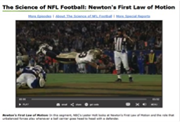 This 4-minute video explores inertia from the context of a running back resisting the force of a defender. The running back is in motion downfield, undergoes an unbalanced force in the direction opposite his motion, and his inertia resists the change in motion. The video explains the connection between mass and inertia in a way that is comprehensible for beginners, even those who struggle with traditional physics curriculum.
This 4-minute video explores inertia from the context of a running back resisting the force of a defender. The running back is in motion downfield, undergoes an unbalanced force in the direction opposite his motion, and his inertia resists the change in motion. The video explains the connection between mass and inertia in a way that is comprehensible for beginners, even those who struggle with traditional physics curriculum.
-
Physlet Physics: Circular Motion and Inertia Warm-Up Exercise
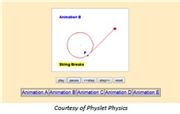 Good warm-up to spark discussion about uniform circular motion and the Law of Inertia. A ball is swung on a string in a circular path. What happens when the string breaks? Students choose from 5 animations that represent possible solutions.
Good warm-up to spark discussion about uniform circular motion and the Law of Inertia. A ball is swung on a string in a circular path. What happens when the string breaks? Students choose from 5 animations that represent possible solutions.
-
UCLA Demoweb: Partial Pie Plate
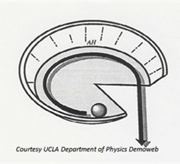 What would happen if an object in circular motion suddenly loses its net centripetal force? Teachers can easily set up this demo to show students that Newton's Law of Inertia will govern the situation, and the object will fly off in a straight line tangential to the circular path. (Note* Try doing this demo after the Physlet exercise directly above.)
What would happen if an object in circular motion suddenly loses its net centripetal force? Teachers can easily set up this demo to show students that Newton's Law of Inertia will govern the situation, and the object will fly off in a straight line tangential to the circular path. (Note* Try doing this demo after the Physlet exercise directly above.)
Applications of Newton’s First Law: Inertia and the Human Body
-
eLearnIn: Spinning Eggs Inertia Demo
 Try using this video to introduce inertia in the context of traumatic brain injury. The demo shows two eggs spinning -- one hard boiled and one raw. Touch your finger to stop the hard-boiled egg and the motion ceases. Touch your finger to stop the raw egg.....it stops for a second then starts spinning again. Why? The liquid yolk, encased in a membrane, continues moving about on its own inertia. The yolk in the hard-boiled egg is solid and experiences the same force applied to the eggshell. Think of our brain as the raw egg. In traumatic head injuries, extensive damage can happen because inertia causes the softer brain tissue to bang around inside the hard skull (like the yolk in the raw egg).
Try using this video to introduce inertia in the context of traumatic brain injury. The demo shows two eggs spinning -- one hard boiled and one raw. Touch your finger to stop the hard-boiled egg and the motion ceases. Touch your finger to stop the raw egg.....it stops for a second then starts spinning again. Why? The liquid yolk, encased in a membrane, continues moving about on its own inertia. The yolk in the hard-boiled egg is solid and experiences the same force applied to the eggshell. Think of our brain as the raw egg. In traumatic head injuries, extensive damage can happen because inertia causes the softer brain tissue to bang around inside the hard skull (like the yolk in the raw egg).
-
MediVisuals: Traumatic Brain Injury Animation
 So why would a neurosurgeon need to know about Newton's First Law? This 6-minute animated video shows what happens inside the brain during collisions. The head is stopped either by an airbag or by contact with a hard surface, but the fragile brain continues to move of its own inertia......colliding against the front, back, and sides of the hard skull. The video shows how this inertial movement can cause axonal shearing and blood vessel rupture, resulting in the death of neurons and permanent brain injury.
So why would a neurosurgeon need to know about Newton's First Law? This 6-minute animated video shows what happens inside the brain during collisions. The head is stopped either by an airbag or by contact with a hard surface, but the fragile brain continues to move of its own inertia......colliding against the front, back, and sides of the hard skull. The video shows how this inertial movement can cause axonal shearing and blood vessel rupture, resulting in the death of neurons and permanent brain injury.
-
NASA: Law of Inertia Video
 This 3-minute video from NASA's Dryden Flight Research Center explores Newton's First Law from the context of both low and high speeds. Kids will sit up and pay attention at the footage of the very-high-acceleration rocket sled showing the effects of rapid stopping on a crash dummy and on NASA's human volunteer, Col. Paul Stapps (photo above). Though his neck & head were restrained, his eyeballs wanted to obey the First Law. The experiment left him temporarily blinded. Memorable way to illustrate that the greater the speed, the greater the resistance to negative acceleration.
This 3-minute video from NASA's Dryden Flight Research Center explores Newton's First Law from the context of both low and high speeds. Kids will sit up and pay attention at the footage of the very-high-acceleration rocket sled showing the effects of rapid stopping on a crash dummy and on NASA's human volunteer, Col. Paul Stapps (photo above). Though his neck & head were restrained, his eyeballs wanted to obey the First Law. The experiment left him temporarily blinded. Memorable way to illustrate that the greater the speed, the greater the resistance to negative acceleration.
Labs and Investigations
-
The Physics Classroom, The Laboratory, Pass the Water
Students compete in a water relay race around an oval track. They observe when the water is most likely to spill (when starting, when stopping, and when turning). Observations are related to Newton's first law of motion.
-
The Physics Classroom, The Laboratory, Galileo for a Day
Students use a friction-pad and a motion detector to explore the effect of decreasing amount of friction on the deceleration of a cart that has been set in motion. Students extrapolate to predict the motion of a cart with no friction.
Other Lab Investigations
-
NASA: Inertial Balance Lab
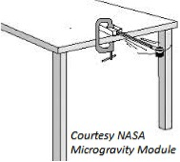 Microgravity environments (such as space shuttles or the ISS) present unique research problems, such as, "How do we measure mass?" Scales and beam balances don't work in microgravity. But you CAN measure mass by employing inertia. This lesson shows how to construct an inertial balance, a spring device you can make with common materials. Students will calculate mass by counting the number of oscillations in 10 seconds and using some pretty simple math. (Data sheets and question set provided.) Students should take away a better understanding of inertia as a property of matter, while weight is dependent on gravity.
Microgravity environments (such as space shuttles or the ISS) present unique research problems, such as, "How do we measure mass?" Scales and beam balances don't work in microgravity. But you CAN measure mass by employing inertia. This lesson shows how to construct an inertial balance, a spring device you can make with common materials. Students will calculate mass by counting the number of oscillations in 10 seconds and using some pretty simple math. (Data sheets and question set provided.) Students should take away a better understanding of inertia as a property of matter, while weight is dependent on gravity.
Demonstration Ideas
-
Inertia Hoop Demonstration
Try this demonstration in front of your students. Place a sewing ring on top of a jug and balance a marker to top of the ring. With a swift swing of your hand, pull the ring out from under the marker, allowing the marker to fall into the jug. The trick (besides physics, of course): pass by the leading edge of the ring and pull on the opposite side of the ring.
-
McMillan Space Center: Newton’s First Law of Motion
 This short video demonstrates a Hero engine at rest being heated enough that steam escapes its pipe "arms". The expulsion of the steam causes the ball to overcome inertia and spin around. Video quality is excellent; narrated explanation will be easy for kids to understand.
This short video demonstrates a Hero engine at rest being heated enough that steam escapes its pipe "arms". The expulsion of the steam causes the ball to overcome inertia and spin around. Video quality is excellent; narrated explanation will be easy for kids to understand.
-
University of Wisconsin Physics Department: Inertia Ball

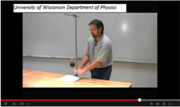 This short video from demonstrates inertia at rest by suspending a heavy ball on a piece of cotton string with two pieces of string hanging off the bottom. If you pull the string very quickly, the force of the pull cannot overcome the ball's inertia and the bottom string will break. Now pull it very slowly but steadily.....the mass of the ball plus the downward tension of the pull will combine, the upper string will break, and the ball will fall.
This short video from demonstrates inertia at rest by suspending a heavy ball on a piece of cotton string with two pieces of string hanging off the bottom. If you pull the string very quickly, the force of the pull cannot overcome the ball's inertia and the bottom string will break. Now pull it very slowly but steadily.....the mass of the ball plus the downward tension of the pull will combine, the upper string will break, and the ball will fall.
-
Sick Science: Inertia Beads

 This short video demonstrates inertia in motion. The demonstrator uses a long strand of plastic beads (about 50m), carefully feeds them into a glass beaker, then gives a sharp tug to the top layer of beads. Voila! The full strand will "climb" over the side of the beaker until the whole thing is on the floor. (You can buy the beads, but regular holiday tree beads will also work.)
This short video demonstrates inertia in motion. The demonstrator uses a long strand of plastic beads (about 50m), carefully feeds them into a glass beaker, then gives a sharp tug to the top layer of beads. Voila! The full strand will "climb" over the side of the beaker until the whole thing is on the floor. (You can buy the beads, but regular holiday tree beads will also work.)
-
Scientific American: Gravity-Defying, Self-Siphoning Metal Beads

 Want to take a deeper dive into the motion of inertia beads? Then check out the slow-motion photography on Scientific American page. The two short videos show how “inertia beads” seem to magically arc above the glass beaker as they make their descent to the ground. The second video is a super-slo-mo view of the effect. *Challenge: We caught the BBC reporter in a few “wrong physics” mistakes in the second video. Can you spot them? Oh…..the print material is accurate. And the super-slo-mo is fantastic.
Want to take a deeper dive into the motion of inertia beads? Then check out the slow-motion photography on Scientific American page. The two short videos show how “inertia beads” seem to magically arc above the glass beaker as they make their descent to the ground. The second video is a super-slo-mo view of the effect. *Challenge: We caught the BBC reporter in a few “wrong physics” mistakes in the second video. Can you spot them? Oh…..the print material is accurate. And the super-slo-mo is fantastic.
Minds On Physics Internet Modules:
The Minds On Physics Internet Modules are a collection of interactive questioning modules that target a student’s conceptual understanding. Each question is accompanied by detailed help that addresses the various components of the question.
-
Newton's Laws, Ass’t NL1 - Inertia, Mass, and Newton's First Law
-
Newton's Laws, Ass’t NL2 - Balanced Forces and the State of Motion
-
Newton's Laws, Ass’t NL3 - Unbalanced Forces and Acceleration
Concept Building Exercises:
-
The Curriculum Corner, Newton's Laws, Inertia and Mass
-
The Curriculum Corner, Newton's Laws, Preconceptions
-
The Curriculum Corner, Newton's Laws, Balanced vs. Unbalanced Forces
Flipped Lesson:
-
PBS Learning Media: Newton’s First and Second Laws 27-minute Video
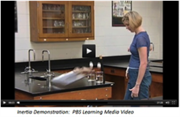 This 27-minute video could be used in a flipped lesson or to provide extra support for struggling readers or students with disabilities. It discusses inertia as a property of matter and goes into depth to differentiate inertia from force. It also includes 4 demonstrations performed by kids to show everyday examples of inertia. At about 17 minutes into the video, it discusses the "rocket sled experiment" of the 1950s: a human volunteer was accelerated to 650 mph, then stopped in 1.2 seconds. Restraint devices kept his body safe, but his eyeballs continued moving under their own inertia. He was temporarily blinded and the tests were stopped. (Good springboard to discuss the ethics of human experimentation.)
This 27-minute video could be used in a flipped lesson or to provide extra support for struggling readers or students with disabilities. It discusses inertia as a property of matter and goes into depth to differentiate inertia from force. It also includes 4 demonstrations performed by kids to show everyday examples of inertia. At about 17 minutes into the video, it discusses the "rocket sled experiment" of the 1950s: a human volunteer was accelerated to 650 mph, then stopped in 1.2 seconds. Restraint devices kept his body safe, but his eyeballs continued moving under their own inertia. He was temporarily blinded and the tests were stopped. (Good springboard to discuss the ethics of human experimentation.)
Real Life Connections:
-
Problem-Based Learning: First Day on the Job Activity
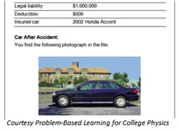 Problem-Based learning activity ideal for your seniors or AP physics students. Using physics, students will determine who is at fault in a car collision. They must figure out the acceleration on impact from a doctor's report of seat belt lacerations and determine displacement from crumple zone measurement. True to the PBL method, the problem introduces relevant and extraneous information. Students must carefully sift to decide which data is useful, then do independent web searches to pull together missing information. Challenging, but not too hard to solve within a two-period lesson. (Note: upon registration, teachers can freely access the Teacher's Guide.)
Problem-Based learning activity ideal for your seniors or AP physics students. Using physics, students will determine who is at fault in a car collision. They must figure out the acceleration on impact from a doctor's report of seat belt lacerations and determine displacement from crumple zone measurement. True to the PBL method, the problem introduces relevant and extraneous information. Students must carefully sift to decide which data is useful, then do independent web searches to pull together missing information. Challenging, but not too hard to solve within a two-period lesson. (Note: upon registration, teachers can freely access the Teacher's Guide.)
Common Misconception:
-
Forces are Required to Sustain a Motion
It can be predicted that students will be rather stubborn in the belief that an object that is moving to the right or upward or northward must be experiencing a force in that direction. It is one of the primary misconceptions addressed by the Minds On Physics Internet Modules. This misconception will surface in a variety of contexts. Make every effort to address in multiple ways and on multiple occasions until students begin to associate force with the acceleration or changes in the way objects move.
-
Forces Persist after the Interaction Ceases
Students who believe that a force is required to sustain a motion will often believe the companion misconception that forces act upon objects even after the interaction with the agent of the force has ceased. For instance, if a ball is thrown up into the air, students will be insistent that the thrower exerts the force that acts upon the ball while it is still moving upward (and after it has left the thrower's hand).
Elsewhere on the Web:
-
Recognizing Forces
This activity describes 11 physical situations and asks students to identify whether specific forces are present or absent. Instant feedback with explanations are given to student answers.
Standards:
Still Under Construction. Standards are coming soon.